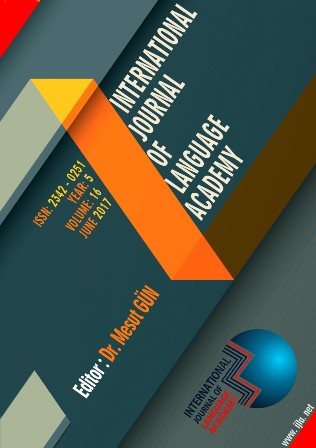Author :
Abstract
In a conversation, the listener isn’t totally silent; He or she produces some vocalizations to show his or her attentiveness, without asking for the turn. These vocalizations which are called “backchannel” have different types and functions in different cultures and languages. This study aims to determine the type and frequency of backchannel responses used in Persian language based on Maynard’s classification. The corpus of the study is 2 hours of conversation, recorded in the dormitory of a university in Tehran. The result of the study shows the most frequent words used as backchannel responses and the functional type of different forms of backchannel response.
Keywords
Abstract
In a conversation, the listener isn’t totally silent; He or she produces some vocalizations to show his or her attentiveness, without asking for the turn. These vocalizations which are called “backchannel” have different types and functions in different cultures and languages. This study aims to determine the type and frequency of backchannel responses used in Persian language based on Maynard’s classification. The corpus of the study is 2 hours of conversation, recorded in the dormitory of a university in Tehran. The result of the study shows the most frequent words used as backchannel responses and the functional type of different forms of backchannel response.
Keywords
- Angles, J., Nagatomi, A., & Nakayama, M. (2000). Japanese responses hai, ee and un: Yes, no, and beyond. Language of Communication, 20, 55-86.
- Coates, J. (2003). Women, men and languages: A sociolinguistics account of gender differences in languages. Harlow: Pearson Education Limited.
- Dixon, J. A., & Foster, D. H. (1998). Gender, social context, and backchannel responses. Journal of Social Psychology, 138, 134136.
- Duncan, S., & Fiske, D. (1977). Face to face interaction: Research, method and theory. Hillsdale, N.J.: Lawrence Erlbaum.
- Feke, M. S. (2003). Effects of native language and sex on back channel behavior. Selected proceedings of the First Workshop on Spanish Sociolinguistics (pp. 96-106). Sommerville: Cascadilla Press.
- Fries, C. C. (1952). The structure of English. New York: Harcourt Brace.
- Gardner, R. (1998). Between speaking and listening: The vocalization of understandings. Applied linguistics, 19, 204-224.
- Heinz, B. (2003). Back channel responses as strategic responses in bilingual speakers’ conversations. Journal of Pragmatics, 35, 1113-1142.
- Ishida, H. (2006). Learner’s perception and interpretation of contextualization cues in spontaneous Japanese conversation: Back channel cue Uun. Journal of Pragmatics, 38, 1943-1981.
- Kita, S., & Ide, S. (2007). Nodding, aizuchi, and final particle in Japanese conversation: How conversation reflects the ideology of communication and social relationships. Journal of Pragmatics, 39, 1242-1254.
- Kogure, M. (2007). Nodding and smiling in silence during the loop sequence of backchannels in Japanese conversation. Journal of Pragmatics, 39, 1275-1289.
- LI, H. Z. (2006). Back channel response as misleading feedback in intercultural discourse. Journal of Intercultural Communication Research, 35, 99-116.
- LI, H. Z. (2010). Back channel responses and enjoyment of the conversation: The more does not necessarily mean the better.
- Maynard, S. K. (1989). Japanese conversation: Self-contextualization through structure and interactional management. Norwood, N.J.: Ablex.
- Miyata, S., & Nisisawa, H. Y. (2007). The acquisition of Japanese backchanneling behavior: Observing the emergence of aizuchi in a Japanese boy. Journal of Pragmatics, 39, 1255-1274.
- Olateju, M. A., & Kehinde, Y. K. (2006). Back channel communication in Ola Rotimi’s Our Husband Has Gone Mad Again. Nordic Journal of African Studies, 15, 520-535.
- Rajan, S., Craig, S. D., Gholson, B., Person, N. K., & Graesser, A. C. (2001). Auto tutor: Incorporating back channel feedback and other human like conversational behaviors into an intelligent tutoring system. International Journal of Speech Technology, 4, 117-126.
- Tao, H. Y., & Thompson, S. A. (1991). English backchannels in Mandarine conversations: A case-study of superstratum pragmatic interference. Journal of Pragmatics, 16, 209-223.
- Truong, K. P., Poppe, R., & Heylen, D. (2010). A rule-based backchannel prediction model using pitch and pause information. Proceedings of Interspeech, 26, 3058-3061.
- Wannaruk, A. (1997). Back channel behavior in Thai and American casual telephone conversations. Suranaree Journal of Science and Technology, 4, 168-174.
